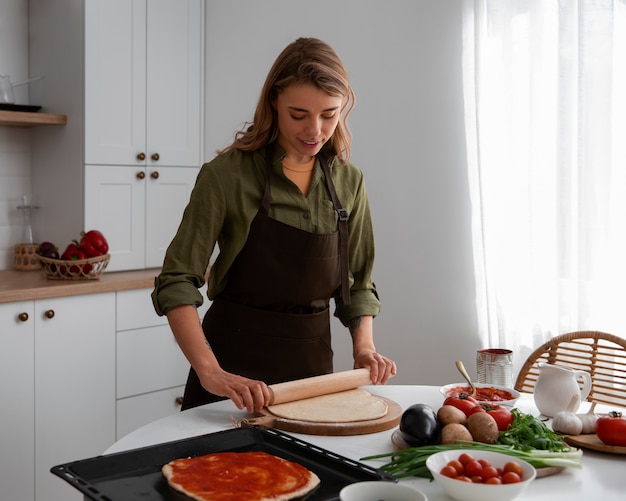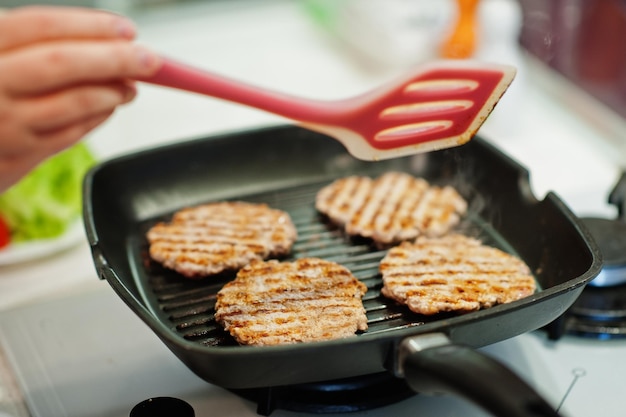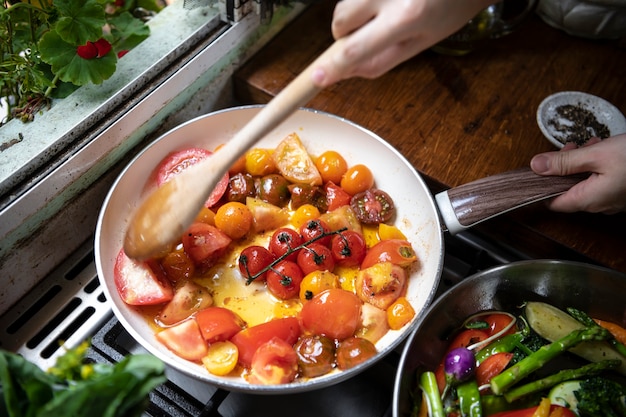Let's face it, bacon is a breakfast staple. It's a universal symbol of deliciousness, bringing smiles to faces worldwide. But achieving that perfect, crispy bacon on the stovetop can feel like a culinary mystery. You know the struggle – sometimes it's limp and chewy, other times you're left with a greasy mess and the lingering scent of smoke.
Well, fear not, bacon enthusiasts! I'm here to share my years of bacon-loving wisdom, honed through countless trials and triumphs. This guide is your secret weapon to consistently achieving crispy, flavorful bacon on the stovetop, without the drama. We'll cover everything from selecting the perfect bacon to mastering the cooking technique, with a sprinkle of tips and tricks along the way. So, grab a cuppa, settle in, and let's get cookin'!
(Part 1) Choosing the Perfect Bacon

Just like selecting the right ingredients for a cake, choosing the right bacon is crucial for achieving a fantastic final result. It's all about finding the perfect balance of flavor and texture.
types of bacon
When it comes to bacon, there's a world of options!
- streaky bacon: This is the classic british bacon, renowned for its thin slices, beautiful streaks of fat, and its ability to render down beautifully, delivering that classic crispy crunch. It's a staple for a traditional fry-up, and my personal favorite.
- back bacon: This is a thicker bacon, often smoked, which offers a richer, more intense flavor. It's usually enjoyed grilled or roasted, but can certainly be cooked on the stovetop with a little extra attention.
- Pancetta: A cured Italian bacon, known for its delicate flavour and beautiful marbling. Pancetta is a bit more expensive, but its flavour is well worth the splurge.
Ultimately, the best type of bacon is the one you enjoy most. But if you're unsure, I recommend starting with good quality streaky bacon. It’s versatile, easy to cook, and always delivers a satisfying crunch.
Thickness Matters
The thickness of the bacon plays a significant role in how it cooks.
- Thin bacon: This cooks quickly and tends to get crispy faster. It's great for a quick fry-up or if you prefer your bacon extra crispy.
- Thick bacon: This needs more time to cook, but it retains its juiciness and offers a more substantial bite. It's perfect for adding to salads or sandwiches.
I prefer a happy medium – a bacon slice that isn’t too thin and not too thick. This way, it cooks evenly and has a nice balance of crispness and tenderness.
What about the Cut?
The cut of bacon also impacts its texture and flavor.
- Regular bacon: This is the most common type, usually cut from the belly of the pig. It’s a good all-rounder with a good mix of fat and lean meat.
- thick-cut bacon: This is thicker with more fat, resulting in more flavor and juiciness. However, it takes longer to cook.
- Center-cut bacon: This cut is leaner, coming from the center of the belly. It's a great choice if you're watching your fat intake, but might lack some of the richness and flavor of regular bacon.
I usually stick with regular bacon, but I love experimenting with thick-cut or center-cut bacon when the mood strikes. It really comes down to personal preference.
(Part 2) Getting Ready to Cook

Now that you've chosen your perfect bacon, it's time to prepare your kitchen for the bacon-cooking adventure. You'll need a few essential tools and a bit of prep work.
Gather Your Gear
Let's make sure you have everything you need:
- A large skillet or frying pan: You'll want a pan that's big enough to hold all your bacon in a single layer, without overcrowding. This helps ensure even cooking and prevents the bacon from steaming instead of crisping.
- Tongs: These are essential for flipping your bacon without burning your fingers. Make sure you use heat-resistant tongs, to avoid any melting mishaps!
- Paper towels: You'll need these to soak up excess grease after cooking. It’s best to have a stack on hand, as you might need to use more than one.
- A cooling rack (optional): A cooling rack is a great addition if you want to take your bacon game to the next level. It allows the bacon to drain completely, preventing it from becoming soggy.
Most of these tools are probably already familiar, but if you're looking to invest in your bacon-cooking journey, a cast-iron skillet is a brilliant choice. It heats up evenly and retains heat well, leading to beautifully crispy bacon. Plus, with proper care, a cast-iron skillet will last you a lifetime!
Preparing the Bacon
Now, let's get down to business. Pre-prepping your bacon will make a world of difference in the final result.
- Pat it dry: Excess moisture can hinder the crisping process. Pat the bacon dry with paper towels before adding it to the pan.
- Don’t overcrowd the pan: Give each slice of bacon its own space to cook. If you overcrowd the pan, the bacon will steam instead of crisp, and you might end up with a soggy mess. It’s best to cook the bacon in batches if necessary.
(Part 3) Mastering the Stovetop Technique

Now for the fun part – cooking the bacon! Here's where I'll share my secret tips for achieving that perfect crunch.
Low and Slow for a Crispy Treat
Most people rush the cooking process, but with bacon, patience is key. Here's the deal: start cooking on low heat. This gives the bacon time to render down its fat slowly and evenly, resulting in a crispier finish. No need to rush things; it’s a slow and steady journey to perfection. Remember, we’re aiming for golden brown goodness, not burnt edges.
Don't Be Afraid of the Fat
Let's talk about the fat. It's not just a byproduct; it's essential for achieving that beautiful golden brown color and crispy texture. So, don’t be afraid of the fat! It’s a flavour enhancer, not a foe. As the bacon cooks, it will release its natural fat. This fat acts as a cooking medium, adding flavour and contributing to the crispy texture.
Don’t Flip Too Often
When you’re cooking bacon, it’s tempting to flip it every few minutes. But trust me, this can actually lead to uneven cooking and a less crispy result. Instead, let the bacon cook undisturbed for a few minutes on each side. This allows the fat to render properly and the bacon to develop a nice golden-brown crust.
Flip Carefully
When it’s time to flip, do it gently with your tongs. We want to avoid breaking the bacon. The goal here is to flip it once, without disturbing the cooking process too much.
The Final Touch: Patience
The last few minutes of cooking are crucial. This is when the bacon really starts to crisp up. Be patient and resist the urge to flip it over and over. Let it cook until it reaches your desired level of crispness.
(Part 4) Knowing When Your Bacon is Ready
How do you know when your bacon is done? Here are a few telltale signs:
The Golden Rule
Keep an eye on the color. As the bacon cooks, it will gradually turn from pale pink to a beautiful golden brown. This is a clear indication that the fat is rendering down and the bacon is getting closer to perfection.
The Crunch Test
As the bacon cooks, it will start to make a gentle crackling sound. This is the sound of the fat rendering and the bacon getting crispy. It’s a delightful sound, really. You’ll know it when you hear it.
The Feel Test
Try this: gently press the bacon with your tongs. If it feels firm and springs back, it’s probably ready. If it feels soft or floppy, give it a few more minutes.
The “Just Right” Test
Ultimately, the best way to know when your bacon is ready is to trust your gut and your taste buds. If it looks golden brown, sounds crispy, and feels firm, it's probably perfect! Don’t be afraid to pull out a slice and take a little taste test.
(Part 5) Draining and Serving Your Bacon
Ok, so your bacon is cooked to perfection. Now, it’s time to drain the excess grease and get ready to serve your delicious creation.
Draining the Bacon
First things first, you need to drain the bacon. You can do this using a few methods:
- Paper towels: This is the easiest and most common method. Simply transfer the bacon to a plate lined with paper towels. The paper towels will absorb the excess grease.
- A cooling rack: If you’re feeling fancy, you can use a cooling rack placed over a baking sheet. This allows the bacon to drain completely, ensuring a crispy texture.
- A slotted spoon: You can use a slotted spoon to lift the bacon out of the pan and place it on a plate or cooling rack. This method is great for avoiding the bacon from getting soggy.
Serving Time!
Now, it's time to enjoy your beautifully cooked bacon. Serve it up with a side of your favourite breakfast items, like eggs, toast, or hash browns. Or, if you’re feeling adventurous, add it to a salad, sandwich, or even a pizza. You can even crumble it up and use it as a topping for soups and stews. The possibilities are endless!
Don’t forget to save the bacon grease! It’s a delicious cooking oil and can be used in countless dishes. You can store it in the fridge for later use.
(Part 6) Tips and Tricks for Stovetop Bacon
Here are a few more tips and tricks to help you master the art of stovetop bacon:
Keep it Even
Always ensure even cooking by placing the bacon in a single layer and leaving enough space between each slice. This prevents the bacon from steaming and ensures that it crisps up evenly. If you have a large batch of bacon, cook it in smaller batches.
The Water Trick
Want to get rid of any excess grease? Add a few tablespoons of water to the pan after you’ve removed the bacon. The water will help to loosen up any remaining grease, making it easier to drain.
The “bacon fat Thermometer”
This is a handy tip I learned from my grandmother. The fat in the pan will start to smoke as it gets hot. If you see smoke, it means the fat is getting too hot and the bacon might burn. Reduce the heat immediately.
The “Flip-and-Repeat” Method
For a super crispy bacon, try this technique: flip the bacon after 3-4 minutes of cooking, then flip it again after another 3-4 minutes. This helps to ensure that both sides get a good amount of cooking time.
The “Bacon-Wrapped” Trick
Want to add a touch of flavour to your bacon? Try wrapping it in other ingredients before cooking. For example, you can wrap it in dates, figs, or even jalapeno peppers for a delicious and unique twist.
(Part 7) Stovetop bacon variations
Now that you’ve mastered the basics, it’s time to get creative. There are endless possibilities when it comes to cooking bacon on the stovetop.
Garlic Bacon
Want a bit of garlic flavour? Simply add a few cloves of minced garlic to the pan with the bacon. The garlic will infuse the bacon with its delicious aroma and flavour.
maple-glazed bacon
Looking for a sweet and salty treat? Before cooking the bacon, mix together a glaze of maple syrup, brown sugar, and a pinch of salt. Towards the end of cooking, brush the bacon with the glaze. The glaze will caramelize and give the bacon a sweet and sticky finish.
Spicy Bacon
Love a bit of heat? Add a pinch of chili flakes or cayenne pepper to the pan. The spice will infuse the bacon, giving it a satisfying kick.
Bacon with Herbs
Want to add a touch of freshness? Add your favourite herbs to the pan while cooking. Some popular choices include thyme, rosemary, or sage. The herbs will infuse the bacon with their unique aromas and flavours.
Bacon-Wrapped Dates
This is a delightful twist on the classic bacon recipe. Simply wrap a strip of bacon around a date, then cook it on the stovetop until the bacon is crispy and the date is soft and gooey. This sweet and salty combination is perfect for a festive appetizer or a unique breakfast treat.
Bacon-Wrapped Asparagus
For a healthy and flavorful dish, wrap bacon around asparagus spears and cook them on the stovetop until the asparagus is tender and the bacon is crispy. This combination is a perfect side dish for a summer barbecue or a light lunch.
(Part 8) Storing Your Bacon
You’ve cooked the perfect bacon. Now, how do you store it? Here are a few tips:
Storing Cooked Bacon
Store cooked bacon in an airtight container in the refrigerator for up to 3 days. You can also freeze cooked bacon for up to 3 months. Just make sure to wrap it tightly in plastic wrap and place it in a freezer-safe bag.
Storing Raw Bacon
Store raw bacon in the refrigerator for up to 7 days. It’s best to keep it in its original packaging. Make sure to keep the raw bacon separated from other foods to prevent cross-contamination.
(Part 9) FAQs: Stovetop Bacon
I’ve answered a lot of your bacon-related questions, but here are a few more frequently asked questions about stovetop bacon.
Q: What’s the best way to prevent bacon from curling?
A: To prevent curling, try these tips:
- Don’t overcrowd the pan. Give each slice of bacon space to cook evenly.
- Start with cold bacon. This gives the fat a chance to render slowly and prevents the bacon from curling prematurely.
- Use a heavy-bottomed pan. A heavy pan helps to distribute heat evenly and prevents the bacon from curling unevenly.
Q: What if the bacon is sticking to the pan?
A: If the bacon is sticking, your pan might not be hot enough. Increase the heat slightly. You can also try adding a bit of butter or oil to the pan.
Q: Is it okay to cook bacon in the oven?
A: Yes, it’s perfectly fine to cook bacon in the oven. This is a great method for cooking a large batch of bacon. Just place the bacon on a baking sheet lined with parchment paper and bake in a preheated oven at 400°F for 15-20 minutes.
Q: Can I cook bacon in the microwave?
A: You can cook bacon in the microwave, but it might not be as crispy as stovetop bacon. You’ll need to use a microwave-safe bacon tray and follow the instructions on the package. Be careful, as the bacon might splatter.
Q: What are some other ways to cook bacon?
A: There are many ways to cook bacon. In addition to stovetop, oven, and microwave, you can also cook it in a grill, a smoker, or even a skillet on the grill. It's really all about finding what works best for you and your taste buds.
And there you have it, my friends! A complete guide to making the best stovetop bacon. Remember, it’s all about choosing the right bacon, understanding the cooking technique, and being patient. So, go forth and conquer your bacon cravings!
Everyone is watching

Corn on the Cob: The Ultimate Guide to Perfectly Cooked Ears
Healthy MealsAh, corn on the cob. Just the name evokes images of sunny days, barbecues, and that sweet, juicy flavour that ...

Perfect Pork Roast Oven Cooking Time: A Guide to Delicious Results
Healthy MealsThere's something truly satisfying about a perfectly roasted pork. The aroma alone is enough to make your mout...

Ham Cooking Time: How Long to Bake, Smoke, or Boil a Delicious Ham
Healthy MealsAh, ham. It's a classic, isn't it? A real crowd-pleaser, especially around holidays. And when done right, it'...

Scallops: The Ultimate Guide to Perfect Cooking
Healthy MealsAh, scallops. Those delicate, sweet, and utterly delicious morsels of the sea. They hold a special place in my...

Spaghetti Squash: The Ultimate Guide to Cooking and Serving
Healthy MealsRemember that time you saw spaghetti squash at the supermarket, looking all bumpy and strange, and thought, "W...
